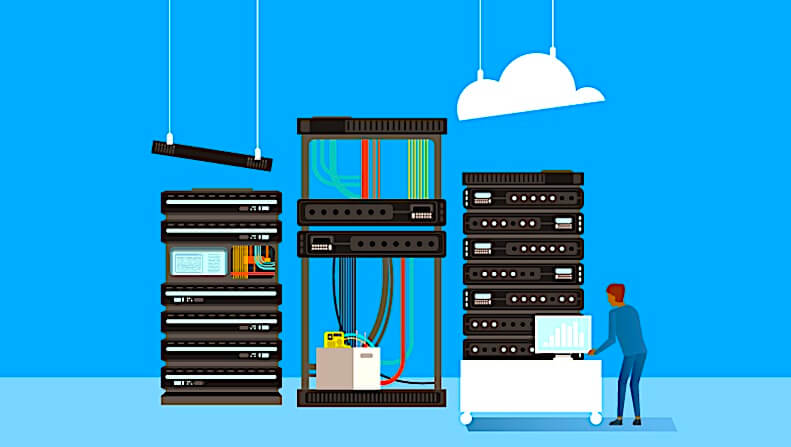There are two main hypervisor types, referred to as Type 1 and Type 2. A type 1 hypervisor acts as a lightweight operating system and runs directly on the host’s hardware, while a type 2 hypervisor runs as a software layer on an operating system, like other computer programs.
The most commonly deployed type of hypervisor is the type 1 or bare-metal hypervisor, where virtualization software is installed directly on the hardware where the operating system is normally installed. Because bare-metal hypervisors are isolated from the attack-prone operating system, they are extremely secure. In addition, they generally perform better and more efficiently than hosted hypervisors. For these reasons, most enterprise companies choose bare-metal hypervisors for data center computing needs.
While bare-metal hypervisors run directly on the computing hardware, hosted hypervisors run on top of the operating system (OS) of the host machine. Although hosted hypervisors run within the OS, additional (and different) operating systems can be installed on top of the hypervisor. The downside of hosted hypervisors is that latency is higher than bare-metal hypervisors. This is because communication between the hardware and the hypervisor must pass through the extra layer of the OS. Hosted hypervisors are sometimes known as client hypervisors because they are most often used with end-users and software testing, where higher latency is less of a concern.
Hardware acceleration technology can create and manage virtual resources faster by boosting processing speed for both bare-metal and hosted hypervisors. A type of hardware accelerator known as a virtual Dedicated Graphics Accelerator (vDGA) takes care of sending and refreshing high-end 3-D graphics. This frees up the main system for other tasks and greatly increases the display speed of images. For industries such as oil and gas exploration, where there is a need to quickly visualize complex data, this technology can be very useful.
Both types of hypervisors can run multiple virtual servers for multiple tenants on one physical machine. Public cloud service providers lease server space on the different virtual servers to different companies. One server might host several virtual servers that are all running workloads for different companies. This type of resource sharing can result in a “noisy neighbour” effect when one of the tenants runs a large workload that interferes with the server performance for other tenants. It also poses more of a security risk than using a dedicated bare-metal server.
A bare-metal server that a single company has full control over will always provide higher performance than a virtual server that is sharing a physical server’s bandwidth, memory and processing power with other virtual servers. The hardware for bare-metal servers can also be optimized to increase performance, which is not the case with shared public servers. Businesses that need to comply with regulations that require physical separation of resources will need to use their own bare-metal servers that do not share resources with other tenants.
What is a hypervisor?
A hypervisor (also called a virtual machine monitor or VMM) is software that creates and runs virtual machines (VM). The hypervisor virtually shares its resources (such as memory and processing), allowing a host computer to support multiple guest VMs
Why use a hypervisor?
Since the guest virtual machine is independent of the host hardware, the hypervisor can use more system resources and provide greater IT mobility. This means that they can be easily moved between different servers. Since multiple virtual machines can be run from one physical server using the hypervisor, the hypervisor reduces:
- Space
- Vitality
- Maintenance requirements

What is a Cloud Hypervisor?
With the popularity of cloud computing, hypervisors have become an invaluable tool for running virtual machines and promoting innovation in a cloud environment. Since a hypervisor is a software layer that enables a host to support multiple VMs at the same time, the hypervisor is a key element of the technology that makes cloud computing possible. The hypervisor enables users in the virtual environment to use cloud-based applications, while still allowing the IT department to maintain control of the cloud environment’s infrastructure, applications, and sensitive data.
Digital transformation and growing customer expectations are driving a greater reliance on innovative applications. In response, many companies are migrating their virtual machines to the cloud. However, having to rewrite every existing application for the cloud consumes valuable IT resources and leads to infrastructure silos. Fortunately, as an integral part of the virtualization platform, hypervisors can help quickly migrate applications to the cloud. As a result, companies can get many benefits from the cloud, including reduced hardware expenditures, increased accessibility, and greater scalability, resulting in a faster return on investment.
How does a hypervisor work?
The hypervisor supports the creation and management of virtual machines (VM) by extracting computer software from the hardware. The hypervisor makes virtualization possible by converting requests between physical and virtual resources. Sometimes the bare metal hypervisor is embedded in the firmware at the same level as the motherboard basic input/output system (BIOS) so that the operating system on the computer can access and use the virtualization software.
Feel free to visit Mondoze Global Blog and Knowledge Base for more information about web hosting.


